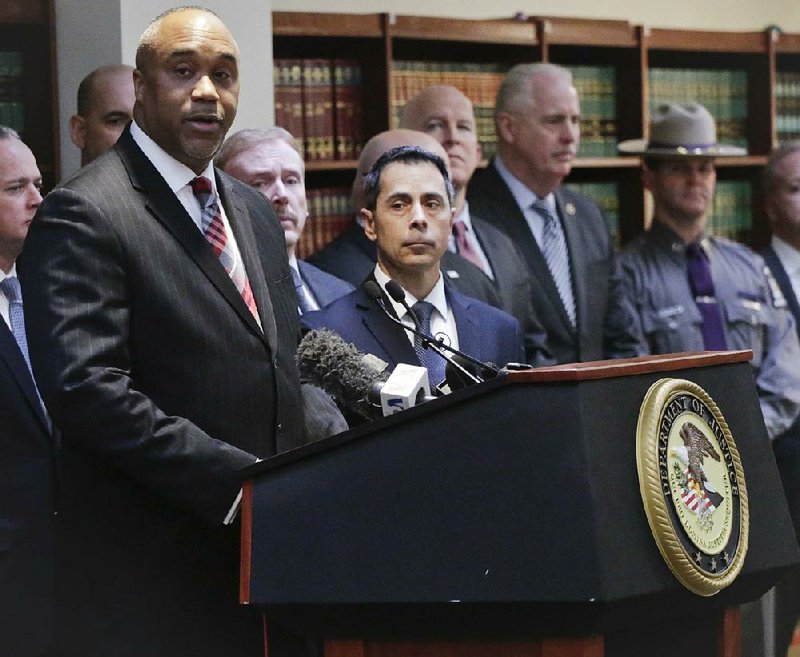NEW YORK -- Mexican drug lord and escape artist Joaquin "El Chapo" Guzman was hauled into a U.S. courtroom Friday and then taken away to an ultra-secure jail that has held some of the world's most dangerous terrorists and mobsters.
Holding his unshackled hands behind his back, Guzman, through his lawyers, entered a plea of innocence to drug trafficking and other charges at a Brooklyn courthouse ringed by squad cars, and officers with assault-style rifles and bomb-sniffing dogs.
"He's a man known for a life of crime, violence, death and destruction, and now he'll have to answer for that," Robert Capers, the U.S. attorney in Brooklyn, said at a news conference.
The court appearance came hours after Guzman's Thursday night extradition from Mexico, where he had become something of a folk hero for two brazen prison escapes.
Guzman was ordered held without bond and was expected to be kept in a special Manhattan jail unit where other high-risk inmates -- including Mafia boss John Gotti and several close associates of Osama bin Laden -- spent their time awaiting trial.
"It is difficult to imagine another person with a greater risk of fleeing prosecution," prosecutors wrote in court papers.
Prosecutors described Guzman as the murderous overseer of a three-decade campaign of smuggling, brutality and corruption that made his Sinaloa drug cartel a fortune while fueling an epidemic of cocaine abuse and related violence in the U.S. in the 1980s and '90s.
Guzman, who is in his 50s, faces the possibility of life in prison if convicted. To get Mexico to hand him over, prosecutors agreed not to seek the death penalty. They also are demanding that he forfeit $14 billion in assets.
Outside court, Guzman defense attorney Michael Schneider said, "I haven't seen any evidence that indicates to me that Mr. Guzman's done anything wrong." He said he would look into whether his client was extradited properly.
The U.S. had been trying to get custody of Guzman since he was first indicted in California in the early 1990s.
When Guzman got off a plane in New York, "as you looked into his eyes, you could see the surprise, you could see the shock, and to a certain extent, you could see the fear, as the realization kicked in that he's about to face American justice," said Angel Melendez, a U.S. Immigration and Customs Enforcement agent.
While Guzman faces federal charges in several U.S. states, federal prosecutors in Brooklyn won the jockeying to get the case. The U.S. attorney's office in Brooklyn has substantial experience prosecuting international drug cartel cases and was once led by former U.S. Attorney General Loretta Lynch.
New York also boasts one of the most secure lockups in the United States, the Metropolitan Correctional Center in Lower Manhattan. The building is protected by steel barricades that can stop up to 7½ tons of speeding truck, and the area is watched by cameras capable of reading a newspaper a block away.
The jail's inmates have included Ramzi Yousef, who was the architect of the 1993 World Trade Center bombing, and multibillion-dollar Ponzi scheme king Bernard Madoff.
In the special high-security wing for the riskiest inmates, around a dozen prisoners spend 23 hours a day in roughly 20-by-12-foot cells, prohibited from communicating with one another. Meals are eaten in cells, and exercise is in a recreation area specifically for those inmates.
Guzman, whose nickname means Shorty, presided over a syndicate that funneled tons of cocaine from South America into the U.S. via tunnels, tanker trucks, planes, container ships, speedboats and even submarines, prosecutors said.
Initially arrested in 1993, he broke out of a maximum-security Mexican prison in 2001, apparently in a laundry cart, and became a folk legend among some Mexicans, immortalized in song.
He was caught in 2014 but escaped again, this time through a hole in his prison cell shower. A specially rigged motorcycle on rails whisked him to freedom through a mile long tunnel. He was recaptured in a January 2016 shootout that killed five associates.
Information for this article was contributed by Verena Dobnik, Larry Neumeister and Jake Pearson of The Associated Press.
A Section on 01/21/2017
